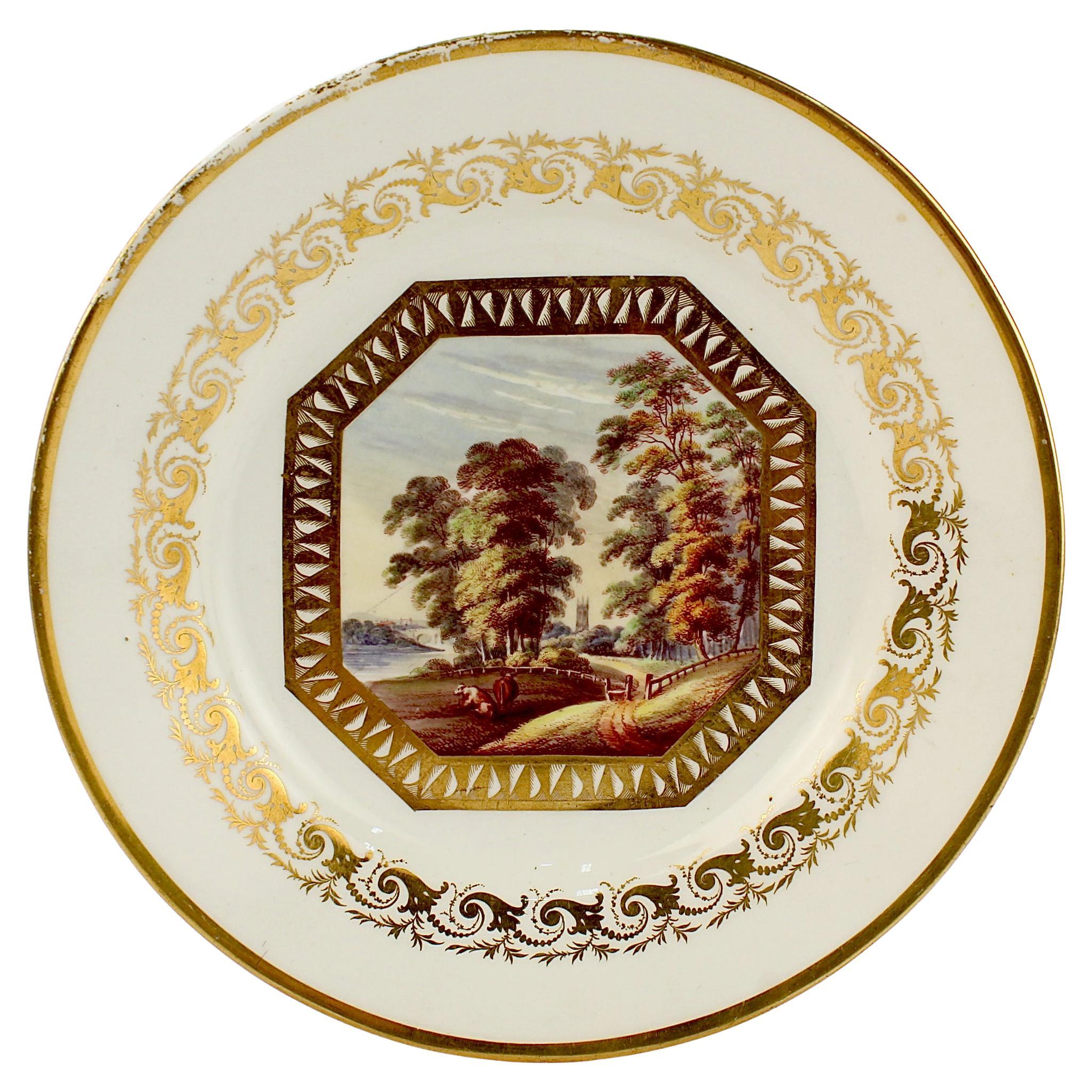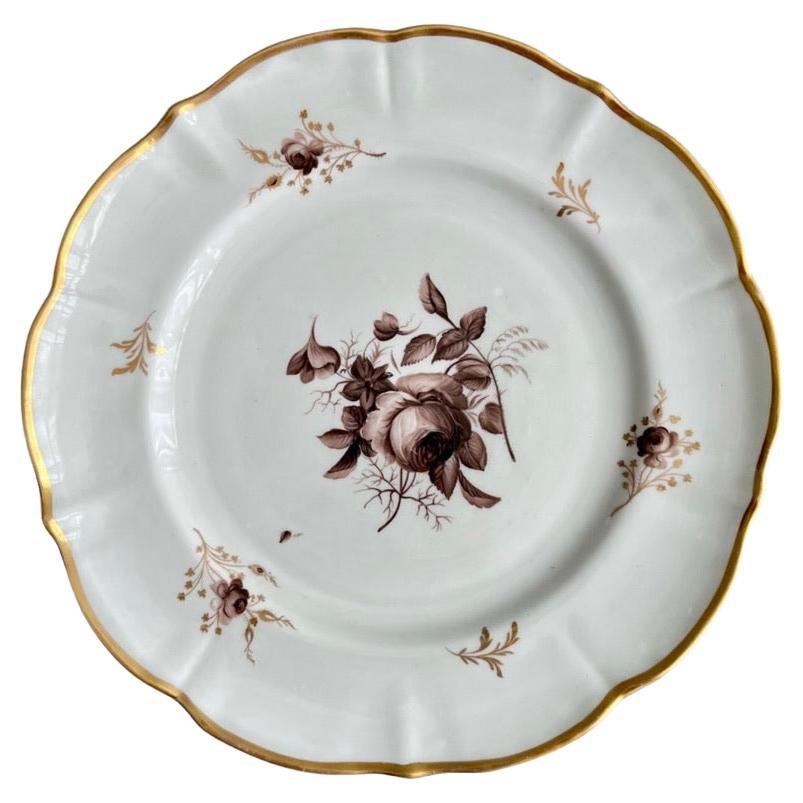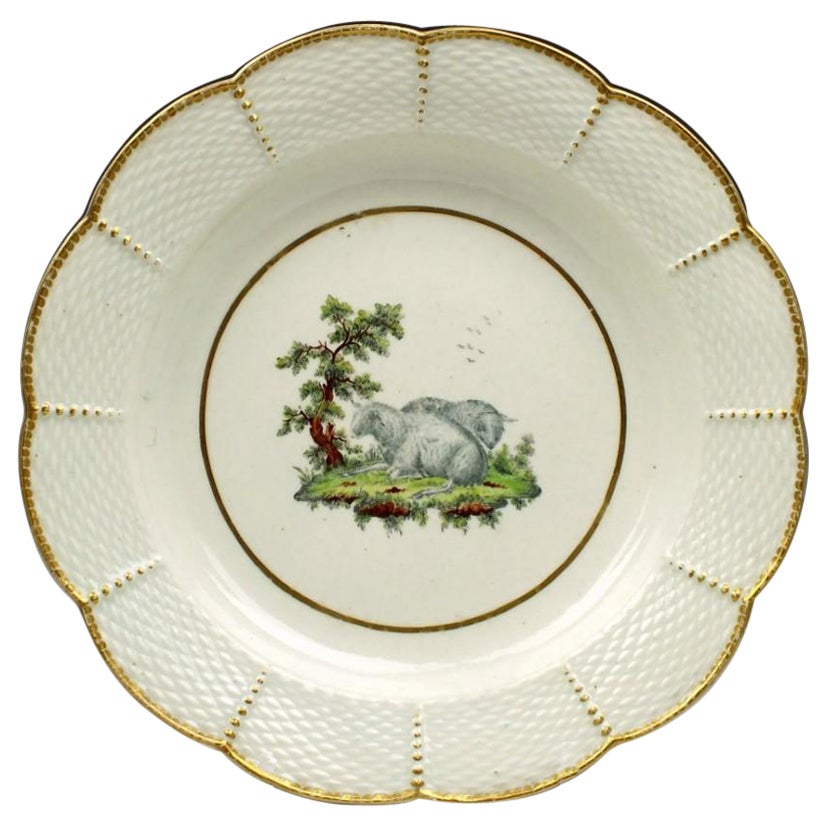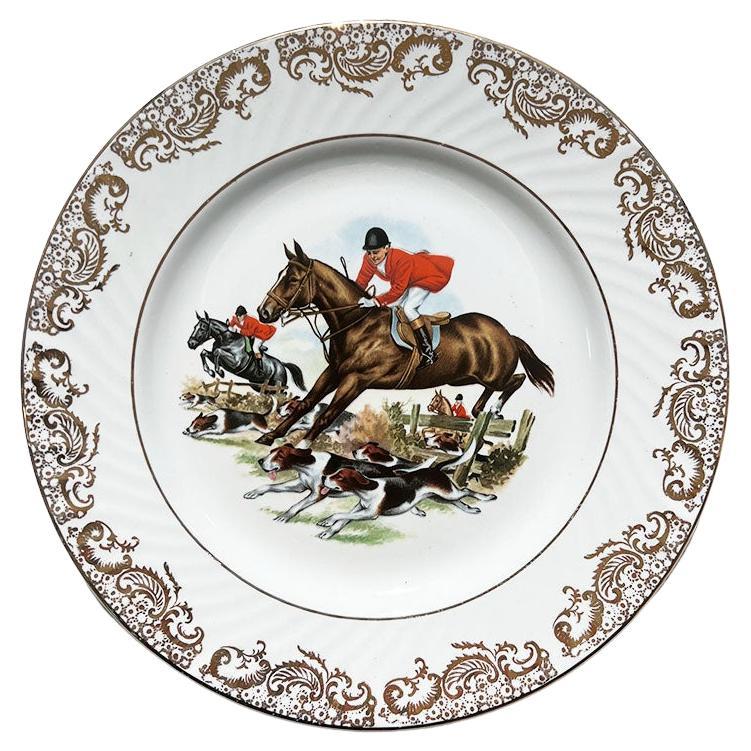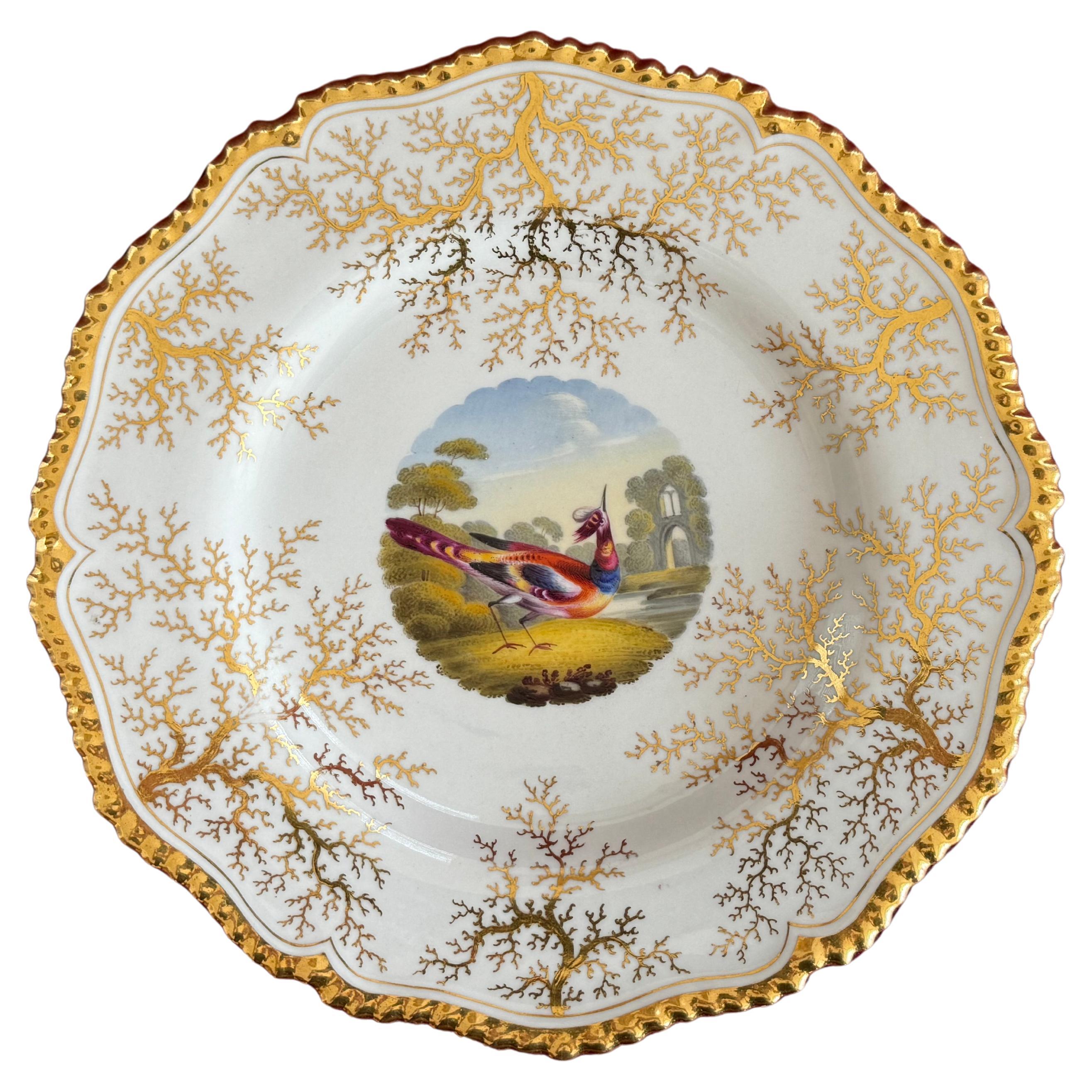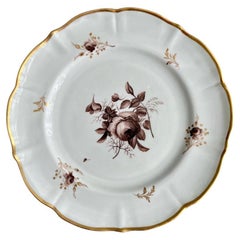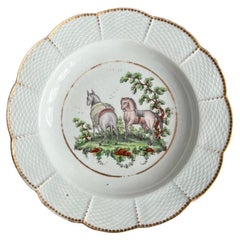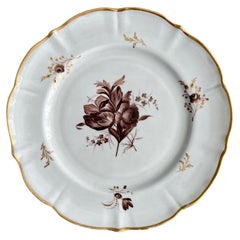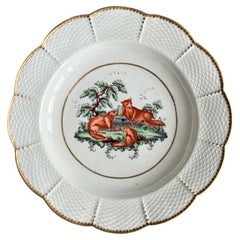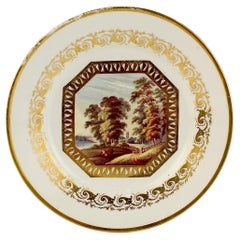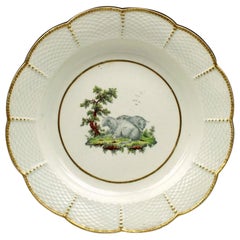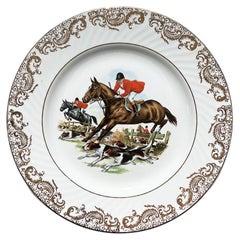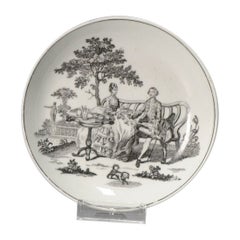Items Similar to Derby Plate, Monochrome Sepia Hunting Scene by John Brewer, ca 1795-1800
Want more images or videos?
Request additional images or videos from the seller
1 of 14
Derby Plate, Monochrome Sepia Hunting Scene by John Brewer, ca 1795-1800
$2,390
£1,814.78
€2,075.34
CA$3,339.18
A$3,713.89
CHF 1,939.28
MX$45,194.13
NOK 24,767.56
SEK 23,227.60
DKK 15,489.06
Shipping
Retrieving quote...The 1stDibs Promise:
Authenticity Guarantee,
Money-Back Guarantee,
24-Hour Cancellation
About the Item
This is a stunning and extremely rare plate made by Derby between about 1795 and 1800. This plate is not only beautiful, it is a true piece of history.
The plate has a nice ribbed rim with a delicate gilt pattern, and a stunning monochrome sepia hunting scene showing a dog chasing a pheasant, held in an octagonal gilt band. The scene was painted by John Brewer, one of the most celebrated painters at Derby. This plate is extremely rare as Brewer didn't usually paint in monochrome sepia, and he also didn't usually paint hunting scenes; he specialised in full colour flowers and beautiful mountain scenery.
The Derby Porcelain factory has its roots in the late 1740s, when Andrew Planché, a Walloon Huguenot refugee, started making simple porcelain toys shaped like animals in his back yard. In 1756 Staffordshire enameller William Duysbury and banker John Heath started a new porcelain factory with Planché and this was to grow out to the largest factory of its time, buying up the bankrupted Chelsea and Bow factories, as well as the stock of several other workshops including that of James Giles. The combination of various traditions, porcelain making skills and sophisticated clients enabled Duesbury to create one of the best porcelain factories of the 18th and 19th Centuries, which after many ups and downs is still operative today.
John Brewer came to work at Derby in 1795 and worked there until his death in 1816. Together with his brother Robert, he was among the best painters at Derby, famous for his very fine landscapes and botanical studies. The brothers came from a well-known family of artists in London, but as the art scene became more crowded in the late 18thC, they chose to explore new avenues. It is said that John, who had never painted on porcelain, switched from being a water colourist to a porcelain painter within one week; a feat that had never been seen before as painting on porcelain is extremely difficult. It is worth carefully studying the brush strokes of this painting; they are extremely fine, and Brewer also scratched away some paint to add additional texture to the painting.
The plate is marked in gold with the Derby crown mark.
CONDITION REPORT The plate is in excellent antique condition without any damage, repairs or crazing, and only some minimal rubbing as visible in the pictures.
Antique British porcelain is never perfect. Kilns were fired on coal in the 1800s, and this meant that china from that period can have some firing specks from flying particles. British makers were also known for their experimentation, and sometimes this resulted in technically imperfect results. Due to the shrinkage in the kiln, items can have small firing lines or develop crazing over time, which should not be seen as damage but as an imperfection of the maker's recipes, probably unknown at the time of making. Items have often been used for many years and can have normal signs of wear, and gilt can have signs of slight disintegration even if never handled. I will reflect any damage, repairs, obvious stress marks, crazing or heavy wear in the item description but some minor scratches, nicks, stains and gilt disintegration can be normal for vintage items and need to be taken into account.
There is widespread confusion on the internet about the difference between chips and nicks, or hairlines and cracks. I will reflect any damage as truthfully as I can, i.e. a nick is a tiny bit of damage smaller than 1mm and a chip is something you can easily see with the eye; a glazing line is a break in the glazing only; hairline is extremely tight and/or superficial and not picked up by the finger; and a crack is obvious both to the eye and the finger. Etcetera - I try to be as accurate as I can and please feel free to ask questions or request more detailed pictures!
DIMENSIONS (diameter) 23cm (9").
- Creator:John Brewer (Artist),Derby (Maker)
- Dimensions:Height: 0.75 in (1.91 cm)Diameter: 9 in (22.86 cm)
- Style:George III (Of the Period)
- Materials and Techniques:
- Place of Origin:
- Period:
- Date of Manufacture:circa 1805
- Condition:Wear consistent with age and use. In perfect antique condition without damage, repairs or crazing, and minor rubbing.
- Seller Location:London, GB
- Reference Number:Seller: HP-DER041stDibs: LU4805142026922
About the Seller
5.0
Gold Seller
Premium sellers maintaining a 4.3+ rating and 24-hour response times
Established in 2016
1stDibs seller since 2019
226 sales on 1stDibs
- ShippingRetrieving quote...Shipping from: London, United Kingdom
- Return Policy
Authenticity Guarantee
In the unlikely event there’s an issue with an item’s authenticity, contact us within 1 year for a full refund. DetailsMoney-Back Guarantee
If your item is not as described, is damaged in transit, or does not arrive, contact us within 7 days for a full refund. Details24-Hour Cancellation
You have a 24-hour grace period in which to reconsider your purchase, with no questions asked.Vetted Professional Sellers
Our world-class sellers must adhere to strict standards for service and quality, maintaining the integrity of our listings.Price-Match Guarantee
If you find that a seller listed the same item for a lower price elsewhere, we’ll match it.Trusted Global Delivery
Our best-in-class carrier network provides specialized shipping options worldwide, including custom delivery.More From This Seller
View AllMansfield Porcelain Plate, Monochrome Sepia Rose W. Billingsley, 1799-1802 (1)
By William Billingsly
Located in London, GB
This is one of a pair of beautiful plates made by William Billingsley at the Mansfield Pottery, between 1799 and 1802. The plates, manufactured by Coalport, have a pleasing slightly diapered shape. They were decorated with beautiful monochrome sepia flowers and a simple gilt rim by William Billingsley.
Please see separate listing for the matching plate; I would be happy to offer some discount if you interested in purchasing both plates.
William Billingsley was a brilliant but notoriously difficult man who left behind a trail of debts, broken hearts and mystery - but he was also one of the most important people in the history British porcelain. Billingsley revolutionised the way British decorators painted flowers; he added a freedom and artistry that now singles out British flower painting, and he created a new technique for painting roses, which you can see in this design. Billingsley trained and worked at Derby, and then started his own pottery at Pinxton. He then left to start a decorating studio at Mansfield, where he decorated wares from various potteries, among which Derby, Coalport, Whitehead and others. After that, he spent a period in Worcester, and then went to Wales where he set up a pottery in Nantgarw, worked at the Swansea pottery for a while and then returned to Nantgarw. While in Nantgarw he created some of the best porcelain ever made, but racking up great debts. He ended up running off in the dead of night and ending his days at Coalport painting flowers.
Items painted by William Billingsley are rare and very much in demand - together with Thomas Baxter's work they are probably among the most desired pieces of British porcelain.
The plate is marked with an impressed 7, the number associated with Billingsley. The attribution of this plate to William Billingsley is due to the fact that he painted nearly identical flowers on a Coalport jug...
Category
Antique Early 1800s English George III Porcelain
Materials
Porcelain
Worcester Porcelain Deep Plate, Aesop Fable Horse and Donkey, ca 1780
By 1st Period Worcester Dr. Wall
Located in London, GB
This is a very rare deep plate made by Worcester around 1780. The plate has a basket weave rim and a very charming image of the Aesop fable of the horse and the donkey in the centre....
Category
Antique 1780s English George III Porcelain
Materials
Porcelain
$1,400 Sale Price
20% Off
Free Shipping
Mansfield Plate, Monochrome Sepia Ranunculus by W. Billingsley, 1799-1802 (2)
By William Billingsly
Located in London, GB
This is one of a pair of beautiful plates made by William Billingsley at the Mansfield Pottery, between 1799 and 1802. The plates, manufactured by Coalport, have a pleasing slightly diapered shape. They were decorated with beautiful monochrome sepia flowers and a simple gilt rim by William Billingsley.
Please see separate listing for the matching plate; I would be happy to offer some discount if you interested in purchasing both plates.
William Billingsley was a brilliant but notoriously difficult man who left behind a trail of debts, broken hearts and mystery - but he was also one of the most important people in the history British porcelain. Billingsley revolutionised the way British decorators painted flowers; he added a freedom and artistry that now singles out British flower painting, and he created a new technique for painting roses, which you can see in this design. Billingsley trained and worked at Derby, and then started his own pottery at Pinxton. He then left to start a decorating studio at Mansfield, where he decorated wares from various potteries, among which Derby, Coalport, Whitehead and others. After that, he spent a period in Worcester, and then went to Wales where he set up a pottery in Nantgarw, worked at the Swansea pottery for a while and then returned to Nantgarw. While in Nantgarw he created some of the best porcelain ever made, but racking up great debts. He ended up running off in the dead of night and ending his days at Coalport painting flowers.
Items painted by William Billingsley are rare and very much in demand - together with Thomas Baxter's work they are probably among the most desired pieces of British porcelain.
The plate is marked with an impressed 7, the number associated with Billingsley. The attribution of this plate to William Billingsley is due to the fact that he painted nearly identical flowers on a Coalport jug...
Category
Antique Early 1800s English George III Porcelain
Materials
Porcelain
Worcester Porcelain Deep Plate, Aesop Fable Three Foxes, ca 1780
By 1st Period Worcester Dr. Wall
Located in London, GB
This is a very rare deep plate made by Worcester around 1780. The plate has a basket weave rim and a very charming image of an Aesop fable about three foxes conversing under a large ...
Category
Antique 1780s English George III Porcelain
Materials
Porcelain
$1,680 Sale Price
20% Off
Free Shipping
Barr Flight & Barr Teacup, Salmon with Monochrome Sepia Landscapes, ca 1810
By Barr, Flight & Barr Worcester
Located in London, GB
On offer is a very rare teacup and saucer made by Barr Flight & Barr in about 1810. The set has a beautifully soft salmon ground colour, an elegant gilt border motif, and beautiful monochrome sepia landscape...
Category
Antique 1810s English Regency Porcelain
Materials
Porcelain
$1,160 Sale Price / set
20% Off
Free Shipping
Samuel Alcock Plate, Inverted Shell, Flowers, Provenance G.A.Godden Regency 1822
By Samuel Alcock & Co.
Located in London, GB
This is a very striking and rare square dessert serving dish made by Samuel Alcock, circa 1822. The dish has a hand painted flower landscape in an unusual style. The dish has provena...
Category
Antique 1820s English Regency Platters and Serveware
Materials
Porcelain
$340 Sale Price
20% Off
Free Shipping
You May Also Like
Antique Topographical Derby English Porcelain Plate Entitled 'Near Derby'
By Derby
Located in Philadelphia, PA
A fine antique 19th century Derby hard paste porcelain plate.
Decorated with a hand painted topographical scene to its center.
The scene depicts a bucolic landscape 'Near Derby' in a gilt cartouche and surrounded by a gilt cornucopia...
Category
Antique 19th Century British George III Dinner Plates
Materials
Porcelain
First Period Worcester Fable Dessert Plate Ex Lever Collection, c1775
By 1st Period Worcester Dr. Wall
Located in Tunbridge Wells, GB
First Period Worcester Fable Dessert Plate Ex Lever Collection, c1775
Additional information:
Date : c1760-80
Period : George III
Marks : Unmarked
Origin : England
Colour : Polychro...
Category
Antique 18th Century English George III Porcelain
Materials
Porcelain
Traditional English Ceramic Hunting Plate by Barratts of Staffordshire England
By Staffordshire
Located in Oklahoma City, OK
A traditional English hunting plate by Barratts of Staffordshire England. This round ceramic plate will be a fabulous accent to a gallery wall. It is gl...
Category
20th Century English American Classical Ceramics
Materials
Ceramic, Paint
Antique Worchester Porcelain Dish Robert Hancock Print English, ca 1770
Located in Amsterdam, Noord Holland
An exquisite and nicely shaped Worcester dish from the 18th century with a transfer printed design by Robert Hancock. Decorated with a version of the 'Tea Party' print.
Robert Hanco...
Category
Antique 18th Century European Decorative Dishes and Vide-Poche
Materials
Porcelain
$956 Sale Price
20% Off
A Flight, Barr & Barr Worcester porcelain dessert plate c.1820
By Barr, Flight & Barr Worcester
Located in Exeter, GB
A Flight, Barr & Barr Worcester porcelain dessert plate c.1820. With gilt gadrooned rim and gilt seaweed background. The central circular well painted with a vignette in bright enamels with an exotic bird against a river landscape, in the manner of Charles Stinton.
Impressed FBB mark along with printed mark referring to Coventry Street address...
Category
Antique 19th Century Porcelain
Materials
Porcelain
$526 Sale Price
20% Off
Podmore Walker Staffordshire Minerva Mythology Sepia Brown Transferware Platter
By Staffordshire
Located in Philadelphia, PA
A stoneware sepia brown transfer printed platter, “Minerva” made by Podmore Walker & Co., Tunstall, Staffordshire, England, circa 1834-1859.
In Mytho...
Category
Antique Mid-19th Century English Regency Platters and Serveware
Materials
Earthenware
More Ways To Browse
Hand Painted Mountain Scene
Hunting Plates
Painted Porcelain Dog
Toy China
Chelsea Plate
Pheasant Glass
Hand Painted Pheasant
Antique Dog Plates
19th Century Hunting Paintings
18th Century George Iii Painting
Hunting Scene China
Derby Chelsea
Sepia Porcelain
Chelsea Porcelain Plate
Huguenot Silver
Antique Toy Dog
Porcelain Hunting Plates
Chinese Porcelain Octagonal Plate
